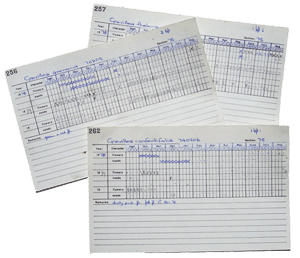Systematics and Evolution (HA)
Phenology of cultivated Australian native plants in relation to climate change
 Cards recording flowering times at ANBG in the 1970s
Cards recording flowering times at ANBG in the 1970s |
Program Leader: Brendan Lepschi
Project Leader: John Busby
Data on flowering times of plants growing in the Australian National Botanic Gardens, collected some 30 years ago, present a rare opportunity to evaluate whether we can detect if Australian native plants now, or at some future time, flower at different times of the year than previously. Any changes in flowering times may indicate responses to climate change.
Background
Between 1974 and 1981, extensive records were collected on flowering times for almost 1600 Australian native plants growing in the Australian National Botanic Gardens (ANBG) in Canberra. In most cases we know not only the species involved, but also the actual individual or at least the genetic stock from which current descendents have been propagated. Included are some parallel records from genetically identical individuals, in some cases planted in close proximity to each other, in others from plantings in different locations in the gardens.
Data were recorded initially on 20 x 12.5 cm cards. Typically, the taxon name, ANBG Property ID, and planting Section were recorded on the top of each card. Many of the Property ID records have subsequently been linked, using the ANBG Integrated Biodiversity Information System (IBIS), to voucher specimens in the Australian National Herbarium.
The body of the cards comprised Year of Record (rows) and Week within Month (columns: 4 weeks for every month, i.e. 48 columns per year). The maximum data recorded on each card was for three years, but many records were for much shorter periods. The body of the data comprised, most commonly, ‘X’ or ‘Fl’ for flowering, ‘B’ or ‘b’ for flower buds present, and ‘.’ for no flowers (or buds) present. The data was recorded by different groups of people over the years and somewhat inconsistently amongst the groups. One recording scheme, in particular, was very complex and took considerable effort to decipher. Both bud and absence data tended not to be recorded in the earlier years.
|
![An Australian Government Initiative [logo]](/images/austgovt_canbr_90px.gif)

![An Australian Government Initiative [logo]](/images/austgovt_canbr_90px.gif)



